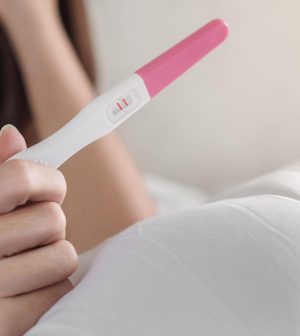- Navigating Your Midlife Crisis: Embracing New Possibilities
- City Raccoons Showing Signs of Domestication
- Mapping the Exposome: Science Broadens Focus to Environmental Disease Triggers
- One Week Less on Social Media Linked to Better Mental Health
- Your Brain Changes in Stages as You Age, Study Finds
- Some Suicide Victims Show No Typical Warning Signs, Study Finds
- ByHeart Formula Faces Lawsuits After Babies Sickened With Botulism
- Switch to Vegan Diet Could Cut Your Greenhouse Gas Emissions in Half
- Regular Bedtime Does Wonders for Blood Pressure
- Dining Alone Could Mean Worse Nutrition for Seniors
Birth Rates Have Risen in States With Abortion Bans

New data shows that births rose in the first half of 2023 in states where abortion bans came into effect following the fall of Roe v. Wade in 2022.
States with bans had an average 2.3% rise in the fertility rate compared to states where abortion remained legal, according to an analysis of preliminary data from the U.S. Centers for Disease Control and Prevention (CDC).
That means around 32,000 more births than expected.
“We don’t always detect signals in these population aggregates because there’s a lot of variation when you group everybody together,” Alison Gemmill, an assistant professor at the Johns Hopkins Bloomberg School of Public Health in Baltimore, told CNN. “The fact that there is a signal at the population level means that something’s really going on. It’s pretty strong evidence.”
Experts note that fertility rates usually don’t undergo significant fluctuations. According to Gemmill, who wasn’t involved in the new analysis, the 4.5% reduction that occurred in the first year of the COVID-19 pandemic was a notable aberration and the largest in decades.
So any sizable uptick in births following the fall of Roe v. Wade is significant, experts said. It suggests that as abortions became harder to obtain, more births occurred.
The new data also showed that fertility rates rose more sharply in states with longer travel times to the nearest legal abortion providers. For example, 2023 fertility rates rose 5.1% in Texas and 4.4% in Mississippi, the data showed.
In terms of demographics, the new research showed that Hispanic women had an especially high uptick (4.7%) in births in the first half of 2023, as did women in their early 20s (3.3%).
“[The Dobbs decision] has had a profound impact on birthing people’s ability to decide what their family looks like and how they navigate that,” Rachel Hardeman, a professor of health and racial equity at the University of Minnesota, told CNN. “All of the material resources necessary for a family to not just barely survive, but to thrive in our society are going to be impacted by their ability to access health care, broadly speaking, and abortion care, specifically.”
More information
Find out more about abortion rates in the United States at KFF.
SOURCE: CNN, Nov. 23, 2023; Institute of Labor Economics, November 2023
Source: HealthDay
Copyright © 2025 HealthDay. All rights reserved.










